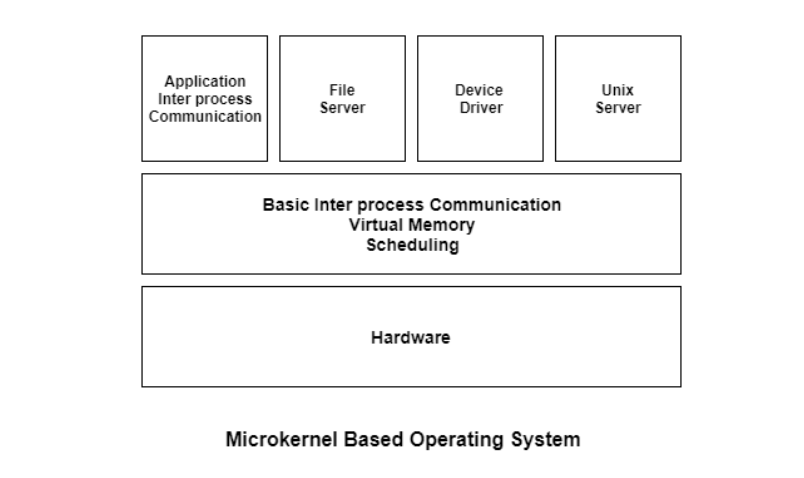
 Data Structure
Data Structure Networking
Networking RDBMS
RDBMS Operating System
Operating System Java
Java MS Excel
MS Excel iOS
iOS HTML
HTML CSS
CSS Android
Android Python
Python C Programming
C Programming C++
C++ C#
C# MongoDB
MongoDB MySQL
MySQL Javascript
Javascript PHP
PHP
- Selected Reading
- UPSC IAS Exams Notes
- Developer's Best Practices
- Questions and Answers
- Effective Resume Writing
- HR Interview Questions
- Computer Glossary
- Who is Who
Architecture of a Typical Microkernel
A microkernel is the minimum software that is required to correctly implement an operating system. This includes memory, process scheduling mechanisms and basic inter-process communication.
A diagram that demonstrates the architecture of a microkernel is as follows −
In the above diagram, the microkernel contains basic requirements such as memory, process scheduling mechanisms and basic interprocess communication. The only software executing at the privileged level i.e. kernel mode is the microkernel. The other functions of the operating system are removed from the kernel mode and run in the user mode. These functions may be device drivers, file servers, application interprocess communication etc.
The microkernel makes sure that the code can be easily managed because the services are divided in the user space. This means that there is less code running in the kernel mode which results in increased security and stability.
Essential Components in a Microkernel
A microkernel contains only the core functionalities of the system. A component is included in the microkernel only if putting it outside would disrupt the functionality of the system. All the other non-essential components are put in the user mode.
The minimum functionalities included in the microkernel are −
- Memory management mechanisms like address spaces are included in the microkernel. This also contains memory protection features.
- Processor scheduling mechanisms are also necessary in the microkernel. This contains process and thread schedulers.
- Interprocess communication is important as it is needed to manage the servers that run their own address spaces.
Performance of a Microkernel System
Providing services in a microkernel system are much more expensive than in a normal monolithic system. The service is obtained by sending an interprocess communication message to the server and getting one in return. This means a context switch or a function call if the drivers are implemented as processes or procedures respectively.
So performance can be complicated in microkernel systems and may lead to some problems. However, this issue is reducing in the modern microkernel systems created such as L4 microkernel systems.
Benefits of Microkernels
Some of the benefits of microkernels are −
- Microkernels are modular and the different modules can be replaced, reloaded, modified, changed etc. as required. This can be done without even touching the kernel.
- Microkernels are quite secure as only those components are included that would disrupt the functionality of the system otherwise.
- Microkernels contain fewer system crashes as compared to monolithic systems. Also, the crashes that do occur can be handled quite easily due to the modular structure of microkernels.


